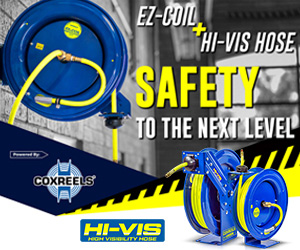
Financial: Good Bad-Debt Tax Savings
By Mark E. Battersby / Published September 2017

Bad debts can be a two-edged sword. The contractor who has debts “forgiven” often has income upon which taxes must be paid. A pressure washing business that has uncollected amounts can write-off or deduct those “bad debts” but only sometimes.
What business owner hasn’t suffered with customers who do not pay? There are often other uncollectible amounts:
- Loans to suppliers or customers
- Debts of an insolvent partner
- Business loan guarantees
- Loan or capital contributions (Naturally, a bad debt deduction for a loan made to a corporation cannot be claimed if the loan is actually a contribution to capital), and
- Debts owed by political parties
Bottom line, no matter how hard you try, you just can’t bring a particular customer’s account to zero. Even after friendly attempts at collection, you haven’t received the total amount owed, and you suspect you never will. At that point, you have a choice: write off the amount as a bad debt, or forgive the debt entirely. Each approach carries trade-offs for small pressure cleaning businesses.
Forgiveness or Write-Offs
Whether as a charitable or goodwill gesture, some small businesses forgive the outstanding debts of customers who may have fallen on hard times. Debt forgiveness simply means the amount due will be written down to zero on the operation’s books along with some sort of note explaining the reason.
The pressure cleaning operation may be able to write off and deduct a business bad debt as an expense on its tax return. Of course, the debt must have been created or acquired by the business or closely related to the business when it became partly or totally worthless. That usually includes goods and services which haven’t been paid for by customers. If the operation is unable to collect any part of those receivables, the remaining outstanding portion could be a legitimate business bad debt.
A pressure cleaning business deducts its bad debts from gross income when figuring its taxable income. Business bad debts may be deducted either in part or in full. All other bad debts are considered to be “nonbusiness.” Nonbusiness bad debts must be totally worthless in order to be tax deductible. The pressure washing operation cannot deduct a partially worthless non-
business bad debt.
“Good” Bad Debts
A bad debt is defined as an account or note receivable that proves to be entirely or partially uncollectible despite collection efforts. Obviously, debt that is not collectible is worthless to the creditor, or it may become uncollectible because the debtor is insolvent. Bad debts are written off as soon as they are determined because the business does not expect future economic benefits, and it no longer remains an asset.
A personal bad debt is normally not deductible, and if allowed deductible by the IRS, it would be treated as a short-term capital loss limited to $3,000 per year.
Unfortunately, just because something may be labeled as a business bad debt doesn’t always make it tax deductible. A bad debt deduction can be claimed only if the amount owed was included in the pressure cleaning operation’s gross income. This is almost never the case for cash method businesses (that means most of us who report income when we receive it). Accrual method pressure cleaning businesses, however, report income as it’s earned; if receivables have already been claimed as income, a bad debt deduction for uncollectible receivables is appropriate.
Business Bad Debts
A business bad debt is a loss from the worthlessness of a debt that originated in one of two ways:
- Created or acquired in a trade or business, or
- Closely related to the trade or business when it became partly or totally worthless.
A debt is closely related to a trade or business if the primary motive for incurring the debt is business related. Bad debts of an incorporated business (other than an S corporation) are always business bad debts.
Business bad debts are usually the result of credit sales to customers. Goods that have been sold but not yet paid for and services that have been performed but not yet paid for are recorded in the pressure cleaning operation’s books as either accounts receivable or notes receivable. After a reasonable period of time, if attempts have been made to collect the amount due but were unsuccessful, the uncollectible part becomes a business bad debt.
Under our tax rules, accounts or notes receivable valued at fair market value (FMV) when received are deductible only at that value, even though the FMV may be less than the face value. If an account receivable was purchased for less than its face value and the receivable subsequently becomes worthless, the most allowed as a tax deduction is the amount paid to acquire it.
When money is loaned to a customer, client, supplier, or employee for a business reason, and the operation is unable to collect the amount after attempting to do so, it is a business bad debt. On the other hand, a bad debt deduction for a loan made to a corporation cannot be claimed if, based on the facts and circumstances, the loan is actually a contribution to capital.
Qualifying
If a contractor or business guarantees a debt that subsequently becomes worthless, that debt, too, can qualify as a business bad debt if all of the following requirements are met:
- The guarantee was made in the course of the trade or business.
- A legal duty to pay the debt exists.
- The guarantee was made before the debt became worthless. This requirement is met where there was a reasonable expectation that the debt would not have to be paid without full reimbursement from the borrower.
- Reasonable consideration for making the guarantee was received. This requirement is met if the guarantee was made in accord with normal business practice or for a good faith business purpose.
The Value of Worthless Debts
Generally, a debt becomes worthless when the surrounding facts and circumstances indicate there is no reasonable expectation of payment. To show that a debt is worthless, a pressure cleaning business must establish that it has taken reason-
able steps to collect the debt. It is not necessary to go to court if it can be shown that a judgment from the court would be uncollectible.
And, as mentioned, the deduction can be claimed only in the year the debt becomes worthless. Naturally, it is not necessary to wait until a debt is due before determining it is worthless. Bankruptcy of the debtor is generally good evidence of the worthlessness of at least a part of an unsecured and unpreferred debt.
Once again, it should be noted that bad debt deductions generally aren’t available to businesses that use the cash method of accounting. To deduct a bad debt, the pressure washer or his or her business must have previously included the amount in income. Since cash-method taxpayers don’t report income until payment is received, no deduction is allowed for uncollectible amounts, even if the money is owed for services performed.
Recovering Bad Debts
If a deduction for a bad debt is claimed on an income tax return and later all or part is recovered (collected), all or part of the recovery amounts may have to be included in the pressure cleaning operation’s gross income. The amount included is limited to the amount actually deducted, but the amount deducted that did not reduce the tax bill can usually be excluded. The recovery is usually reported as “Other Income” on the appropriate business form or schedule.
Should property be received in partial settlement of a debt, the debt is reduced by the property’s fair market value (FMV), which becomes the property’s basis or book value. The remaining debt can be deducted as a bad debt if and when it becomes worthless. Should the property later be sold for more than its basis, any gain on the sale is due to the appreciation of the property. It is not a recovery of a bad debt.
Besides costing the pressure cleaning operation money, bad debts complicate accounting. When using accrual-basis accounting (as many businesses are actually required to do), income occurs at the time of sale, not when it actually comes in. Because of the time lag as the non-paid sale becomes an overdue account, many businesses go through various collection procedures, with the overdue account eventually becoming a bad debt deductible on the operation’s tax return.
To ensure the pressure cleaning operation doesn’t miss out on a bad debt deduction, it must be able to show the debt is partially or totally worthless. What’s more, the tax law doesn’t allow a deduction for any part of a debt after the year in which it becomes totally worthless.
Records should be reviewed carefully to pinpoint any potentially worthless receivables carried on the books. Because of potential IRS challenges, all failed collection efforts should be carefully documented. Beware, however, that this area of our tax law is tricky, so seeking professional assistance is strongly recommended.





